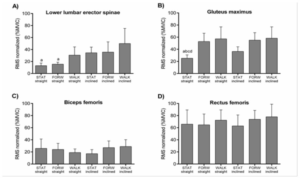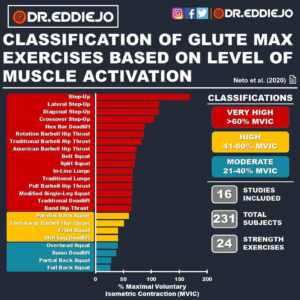SPLIT SQUATS – BACK FOOT ON THE FLOOR
Click on Image to Enlarge
MOMENT ARM STUDY
UPPER GLUTE MAX, GLUTE MEDIUS, TFL
– Split Squat with Long & Short Strides
Joint Angles of Ankle, Knee, and Hip and Loading Conditions During BB Split Squats – 2013 – Schutz 
Procedure
– 11 subjects performed split squats with an additional load of 25% body weight applied using a barbell
– 60º Shin Angle = Knee over Toes; 75º Shin Angle = Knee over Mid-Foot; 90º Shin Angle = Vertical
Results – NJM – Net Joint Moment Angle
1. Longer stride + 60º shin angle = Increased Hip Extension = Glute dominant
2. Shorter stride + 90º shin angle = Increased Knee Extension = Quad dominant
EMG STUDIES
GLUTEUS MAXIMUS, RECTUS FEMORIS, ERECTOR SPINAE
– Split Squat vs. Forward Lunge vs. Walking Lunge
Influence of Trunk Position during 3 Lunge Exercises in Trained Women – 2021 – Bezerra
Procedure
– trained young women ≥1 year with an overload of 30% of body weight in 6 conditions
A. STAT Lunge (Split Squat): maximally flexing RT knee (~90° – 100°); return to initial position
B. FORW Lunge: step forward flex RT knee (~90° – 100°); return to initial position by pushing RT foot backward
C. WALK Lunge: step forward flex RT knee (~90° – 100°); then take a step, pushing LT foot forward to a standing position
Electrodes
GMax: halfway b/n distance of greater trochanter and 2nd sacral vertebra in the belly of the muscle
Rectus Femoris: 1/3 proximal b/n distance of anterior superior iliac spine and superior side of patella
Biceps Femoris: halfway b/n distance of ischial tuberosity and lateral epicondyle of tibia
Lower Lumber Erector Spinae: 3 cm lateral to spine and nearly level with iliac crest b/n L3 and L4 vertebrae
Results – Level
Gluteus Maximus: Walking 55 . Forward or Lunge Return 50 . Static or Split Squat 25
Rectus Femoris: Walking 70 . Forward or Lunge Return 65 . Static or Split Squat 65
+ Biceps Femoris: Static or Split Squat 26 . Forward or Lunge Return 22 . Walking 18
+ Lower Erector Spinae: Walking 30 . Forward or Lunge Return 15 . Static or Split Squat 10
Results – Forward Leaning Upper Body on Inclined Treadmill
Gluteus Maximus: Walking 55 . Forward or Lunge Return 55 . Static or Split Squat 40
Rectus Femoris: Walking 75 . Forward or Lunge Return 70 . Static or Split Squat 65
+ Biceps Femoris: Walking 28 . Forward or Lunge Return 24 . Static or Split Squat 16
+ Lower Erector Spinae: Walking 50 . Forward or Lunge Return 35 . Static or Split Squat 35
 1
1
GLUTEUS MAXIMUS
– Split Squat
Glute Max Activation during Common Strength and Hypertrophy Exercises – 2020 – Neto
Procedure & Results
– GMax activation levels during strength exercises that incorporate hip extension and use of external load
– the following factors might directly influence GMax activation
(1) External load (2) movement velocity (3) level of fatigue (4) complexity of the exercise (5) need for joint stabilization
– Step-up may elicit the highest level of Gmax activation possibly due to the stabilization requirement
| Classification | Activation | Exercise | Average (%MVIC) |
|---|---|---|---|
| 1º | Very high | Step-Up | 169.22 ± 101.47 |
| 2° | Very high | Lateral Step-Up | 114.25 ± 54.74 |
| 3° | Very high | Diagonal Step-Up | 113.21 ± 43.54 |
| 4° | Very high | Crossover Step-up | 104.19 ± 33.63 |
| 5° | Very high | Hex Bar Deadlift | 88 ± 16 |
| 6° | Very high | Rotation BB Hip Thrust | 86.18 ± 34.3 |
| 7° | Very high | Traditional BB Hip Thrust | Lower GM: 69.5/Upper GM: 86.7 |
| 8° | Very high | American BBHip Thrust | Lower GM: 57.4 ± 34.8/ Upper GM: 89.9 ± 32.4 |
| 9° | Very high | Belt Squat | 71.34 ± 29.42 |
| 10° | Very high | Split Squat | 70 ± 15 |
| 11° | Very high | In-line Lunge | 67 ± 11 |
| 12° | Very high | Traditional Lunge | 66 ± 13 |
| 13° | Very high | Pull Barbell Hip Thrust | 65.87 ± 23.28 |
| 14° | Very high | Modified Single-leg Squat – Bulgarians | 65.6 ± 15.1 |
| 15° | Very high | Traditional Deadlift | 64.50 ± 41.72 |
| 16° | Very high | Band Hip Thrust | Lower GM: 49.2 ± 26.5/ Upper GM: 79.2 ± 29.9 |
| 17° | High | Parallel Back Squat | 59.76 ± 22.52 |
| 18° | High | Feet-away Barbell Hip Thrust | 51.38±17.93 |
| 19º | High | Front Squat | 40.54 ± 4.73 |
| 20° | High | Stiff-Leg Deadlift – RDL | 40.5 ± 18.8 |
| 21° | Moderate | Overhead Squat | 39.75 ± 29.91 |
| 22° | Moderate | Sumo Deadlift | 37 ± 28 |
| 23° | Moderate | Partial Back Squat | 28.16 ± 10.35 |
| 24° | Moderate | Full Back Squat | 26.56 ± 12.33 |
UPPER GLUTEUS MAXIMUS, GLUTEUS MEDIUS & TFL
– Split Squat
Which Exercises Target the Glutes While Minimizing Activation of the TFL? – 2013 – Selkowitz 
Procedure
– which exercises are best for GMed and superior portion of GMax, while minimizing activity of TFL
Fine Wire Electrodes
– Sup-Gmax: midpoint of line drawn b/n posterior superior iliac spine and posterior GT
– GMed: 2.5 cm distal to midpoint of iliac crest (ie, middle portion)
– TFL: distal and slightly lateral to anterior superior iliac spine and medial and superior to GT
Results
| Exercise | Tensor Fascia Lata | Gluteus Medius | Superior Gluteus Maximus |
|---|---|---|---|
| Side-lying hip abduction | 32.3 ± 13.1 | 43.5 ± 14.7 | 23.7 ± 15.3 |
| Bilateral bridge – Hip Thrust | 8.2 ± 7.4 | 15.0 ± 10.5 | 17.4 ± 11.9 |
| Clam | 11.4 ± 11.4 | 26.7 ± 18.0 | 43.6 ± 26.1 |
| Hip hike | 31.4 ± 14.4 | 37.7 ± 15.1 | 17.7 ± 15.2 |
| Lunge | 21.6 ± 14.5 | 19.3 ± 12.9 | 20.1 ± 11.1 |
| Quadruped hip ext, knee extending | 15.6 ± 9.3 | 27.3 ± 14.9 | 28.5 ± 16.6 |
| Quadruped hip ext, knee flexed | 18.7 ± 10.6 | 30.9 ± 15.2 | 30.1 ± 12.5 |
| Sidestep | 13.1 ± 7.1 | 30.2 ± 15.7 | 27.4 ± 16.7 |
| Squat | 4.6 ± 3.8 | 9.7 ± 7.3 | 12.9 ± 7.9 |
| Step-up | 21.4 ± 11.4 | 29.5 ± 14.9 | 22.8 ± 15.6 |
| Unilateral bridge – Hip Thrust | 18.1 ± 12.9 | 30.9 ± 20.7 | 34.6 ± 16.8 |
.



